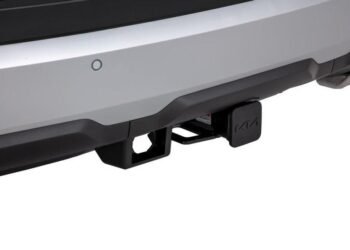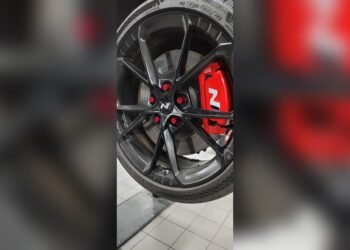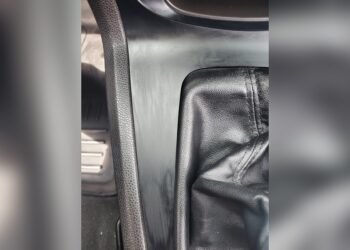Is your car’s hood insulation worn out, sagging, or falling apart? You might not realize it, but hood insulation plays a key role in protecting your engine, reducing noise, and even helping control temperature under the hood.
When it’s damaged, your car can get noisier, hotter, and less efficient. But don’t worry—you don’t have to live with that problem. Whether you want to fix it yourself or find the right professional help, this guide will walk you through everything you need to know about repairing hood insulation.
Keep reading to discover simple, effective solutions that will save you money and keep your car running smoothly.

Credit: www.youtube.com
Signs Of Damaged Hood Insulation
Damaged hood insulation can cause several issues for your vehicle. It protects your engine from heat and reduces noise. Signs of damage often appear slowly but can worsen over time. Detecting these signs early helps avoid costly repairs. This section explains common signs that indicate hood insulation needs repair.
Common Wear And Tear Issues
Hood insulation faces constant exposure to heat and moisture. This causes gradual wear and tear. The material may become brittle and start to crumble. Dirt and debris can also cause damage. Over time, the insulation loses its effectiveness. Regular checks can spot these issues early.
Identifying Sagging And Holes
Sagging insulation hangs loosely from the hood. It may appear uneven or droop in spots. Holes or tears are clear signs of damage. Rodents sometimes chew on the insulation, creating gaps. These problems reduce heat protection and sound absorption. Visual inspection helps find sagging or holes quickly.
Effects On Engine Noise And Heat
Damaged insulation cannot block engine noise well. You may hear more engine sounds inside and outside the car. Heat can also escape through damaged spots. This raises the hood temperature and stresses engine parts. Proper insulation keeps noise and heat at safe levels.

Credit: www.amazon.com
Materials For Hood Insulation Repair
Repairing hood insulation requires choosing the right materials. The materials protect your vehicle from heat and noise. Using quality materials ensures long-lasting results and better performance. This section breaks down the main materials used for hood insulation repair. Understanding these helps you pick the best option for your needs.
Types Of Insulation Pads
Insulation pads are the core material for hood insulation. They come in various types, including fiberglass, foam, and felt. Fiberglass pads resist heat well and are common in many vehicles. Foam pads offer lightweight insulation and are easy to handle. Felt pads absorb sound and provide moderate heat resistance. Selecting the right pad depends on your vehicle and repair needs.
Sound Deadening Options
Sound deadening materials reduce engine noise under the hood. Rubberized mats and butyl sheets are popular choices. These materials stick to the hood’s underside to block noise. They also help prevent vibration and rattling. Adding sound deadening improves driving comfort by lowering noise levels.
Heat Shielding Materials
Heat shielding protects the hood and nearby parts from engine heat. Aluminum foil and reflective barriers are common heat shields. These materials reflect heat away from the hood surface. They prevent paint damage and reduce heat transfer to the cabin. Proper heat shielding extends the life of your vehicle’s hood.
Adhesives And Fasteners
Secure hood insulation with the right adhesives and fasteners. High-temperature spray adhesives bond insulation pads firmly. Clips and push pins hold the insulation in place. Using strong adhesives and fasteners prevents sagging or falling insulation. This keeps the hood insulation intact and effective for longer.
Preparing For Repair
Preparing for hood insulation repair requires careful steps to ensure a lasting fix. The process starts with removing the old insulation that may be damaged or worn out. Proper cleaning of the hood surface follows to create a smooth base. Gathering the right tools makes the job easier and safer. Each step helps improve the quality and durability of the new insulation.
Removing Old Insulation
Begin by carefully peeling off the old insulation. Use a scraper or a putty knife to lift stubborn areas. Avoid damaging the hood’s surface during removal. Dispose of the old material properly to keep your workspace clean. Removing all remnants prevents bumps under the new insulation.
Cleaning The Hood Surface
After removal, clean the hood surface thoroughly. Use a degreaser or mild soap with water to remove dirt and oil. Rinse well and let the surface dry completely. A clean surface helps the new insulation stick better. It also prevents rust and extends the hood’s life.
Tools Needed For The Job
Prepare tools before starting the repair. Common tools include a scraper, gloves, cleaning cloths, and a degreaser. You may also need adhesive spray or heat-resistant glue. A utility knife helps cut new insulation to size. Having all tools ready saves time and avoids interruptions.
Step-by-step Repair Process
Repairing hood insulation requires careful attention to detail. A step-by-step process ensures the job is done right. This improves heat protection and noise reduction in your vehicle.
Follow these clear steps for a successful repair. Each step focuses on precision and proper installation techniques. Keep your work area clean and organized for best results.
Measuring And Cutting New Insulation
Start by measuring the damaged area under the hood. Use a tape measure for accurate dimensions. Mark the measurements on the new insulation material. Cut the insulation carefully with sharp scissors or a utility knife. Make sure the pieces fit the hood shape well.
Fitting And Adjusting The Material
Place the cut insulation inside the hood. Check for any gaps or overlaps around the edges. Trim small areas if the fit is too tight. Adjust the material until it lies flat and smooth. Proper fitting prevents future sagging or damage.
Applying Adhesive Or Fasteners
Choose a high-temperature adhesive or suitable fasteners for your insulation type. Spread the adhesive evenly on the hood surface or insulation backing. Allow the adhesive to become tacky before applying. If using fasteners, align them to secure the insulation firmly. Avoid using low-quality glue that melts under heat.
Securing Insulation To The Hood
Press the insulation firmly against the hood surface. Hold it in place for several minutes to ensure a strong bond. Attach fasteners evenly around the edges for extra security. Check that the insulation does not move or sag after installation. This step keeps the insulation stable during vehicle use.
Diy Fixes For Minor Damage
Minor damage to hood insulation can reduce its effectiveness. Small tears, loose edges, or worn spots often do not require full replacement. Simple DIY fixes can help restore protection and extend insulation life. These quick repairs save time and money. Here are some easy methods to fix minor damage to your hood insulation.
Using Duct Tape And Velcro
Duct tape offers a strong, flexible hold on torn insulation. Cut a piece slightly larger than the damaged area. Press it firmly over the tear to seal and protect. Velcro strips help reattach loose insulation panels. Stick one side to the hood and the other to insulation. This allows easy removal for future repairs or cleaning.
Applying Protective Coatings
Protective coatings help shield insulation from heat and moisture. Use spray-on heat-resistant coatings designed for automotive use. Apply evenly over the insulation surface. This layer prevents further wear and adds durability. Choose products that dry quickly and resist peeling.
Temporary Patch Solutions
Temporary patches work well for quick fixes before full repair. Use high-temperature foam or fiberglass patches cut to fit the damaged spot. Attach patches with adhesive suitable for engine heat. These patches block heat and sound until a permanent fix is possible. Check patches regularly for stability.
Credit: www.tacomaworld.com
Professional Repair And Replacement
Professional repair and replacement of hood insulation protect your engine and improve vehicle comfort. Proper insulation reduces heat damage and noise inside the cabin. Skilled technicians ensure safe removal and fitting of new materials. Their expertise prevents damage to the hood and engine components.
Choosing professional service guarantees quality work and long-lasting results. Experts use correct tools and materials designed for your vehicle. They inspect the hood for hidden damage and fix problems thoroughly. Trusting a professional avoids common DIY mistakes and wasted time.
When To Call A Specialist
Call a specialist if the insulation is torn, sagging, or missing. Strange engine noises or excessive heat under the hood are signs. If DIY repairs fail or you notice unusual odors, seek help. Professionals can spot hidden damage and prevent costly repairs.
Cost Estimates For Services
Repair costs vary by vehicle make, model, and damage extent. Basic repairs may cost less, while full replacement is higher. Labor charges depend on local rates and work complexity. Ask for a detailed estimate before approving any service. Investing in quality repair saves money over time.
Choosing Oem Vs Aftermarket Parts
OEM parts come from the vehicle maker and fit perfectly. Aftermarket parts can be cheaper but vary in quality and fit. OEM ensures warranty and exact match to original insulation. Aftermarket options offer more choices but require careful selection. Discuss options with your technician to decide best fit.
Maintaining Hood Insulation
Maintaining hood insulation is key to protecting your vehicle’s engine and improving efficiency. Proper care prevents damage and keeps the insulation effective. Simple steps can extend its life and save costly repairs.
Preventing Rodent And Weather Damage
Rodents chew on hood insulation, causing holes and tears. Use rodent repellents or traps near the vehicle. Keep the engine bay clean to avoid attracting pests. Weather also harms insulation by causing moisture buildup. Park in shaded or covered areas to reduce exposure. Replace damaged insulation quickly to prevent further issues.
Regular Inspection Tips
Check hood insulation at least twice a year. Look for signs of wear like cracks, sagging, or discoloration. Use a flashlight to spot hidden damage under the hood. Listen for unusual engine noises, which may signal insulation problems. Early detection helps maintain performance and safety.
Extending Insulation Lifespan
Keep the hood clean and dry to protect insulation. Avoid harsh chemicals when cleaning the engine bay. Use heat-resistant sprays to strengthen insulation material. Secure loose insulation with clips or adhesive pads. Replacing damaged sections promptly avoids bigger repairs later.
Benefits Of Proper Hood Insulation
Proper hood insulation offers several important benefits for your vehicle. It helps reduce noise, protects the paint, and improves comfort inside the car. These advantages keep your engine running smoothly and your driving experience pleasant. Maintaining good hood insulation is a smart choice for any vehicle owner.
Reducing Engine Noise
Hood insulation acts as a sound barrier. It absorbs and blocks engine noise from reaching the cabin. This creates a quieter ride and less distraction for the driver. Reduced noise also means less stress during long drives. Proper insulation keeps your vehicle peaceful and calm.
Protecting Paint From Heat
Engine heat can damage the paint on the hood over time. Insulation helps to shield the paint from extreme temperatures. This prevents fading, cracking, and bubbling of the paint surface. Keeping the paint safe maintains the vehicle’s appearance and value. Insulation acts as a heat guard for your hood.
Improving Vehicle Comfort
Good hood insulation controls heat transfer into the cabin. It keeps the interior cooler in hot weather and warmer in cold weather. This helps the air conditioning and heating systems work better. Drivers and passengers enjoy a more comfortable environment. Proper insulation enhances overall driving comfort.
Frequently Asked Questions
How To Fix Car Hood Insulation?
Clean the hood surface thoroughly. Remove old insulation and adhesive. Apply new heat-resistant adhesive and press replacement insulation firmly. Allow it to dry fully before closing the hood. Use high-quality hood insulation material for best results.
How Much Does It Cost To Replace Hood Insulation?
Replacing hood insulation typically costs between $50 and $150, depending on the car model and material quality. DIY replacement reduces labor costs.
What Can I Use As Hood Insulation?
Use foil foam insulation, fiberglass mats, or heat-resistant sound deadening mats as effective hood insulation options.
Can You Drive Without Hood Insulation?
Yes, you can drive without hood insulation. It mainly reduces engine noise and protects the hood from heat damage.
What Is Hood Insulation And Why Is It Important?
Hood insulation reduces engine noise and protects the hood from heat damage.
Conclusion
Repairing hood insulation keeps your engine safe and quiet. It prevents heat damage and reduces noise effectively. Simple fixes save money and extend your vehicle’s life. Regular checks catch issues before they grow worse. Use quality materials for best results.
A well-maintained hood insulation improves driving comfort. Don’t ignore worn or damaged insulation parts. Small repairs today avoid costly replacements tomorrow. Take action to protect your car’s performance and value.

















